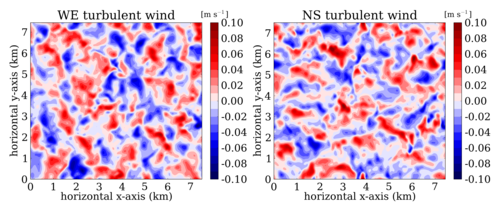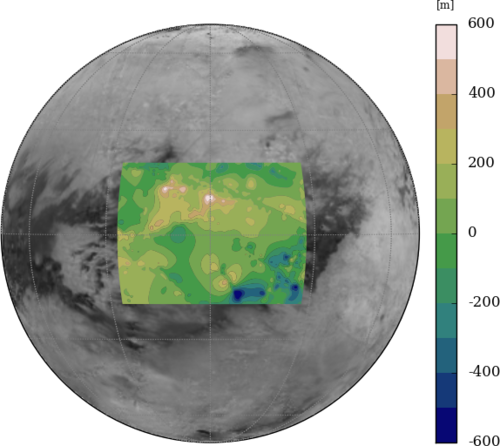Developping a new model for mesoscale and large-eddy simulations of Titan's atmosphere
- 1Laboratoire de Météorologie Dynamique (LMD), Sorbonne Université, Centre National de la Recherche Scientifique (CNRS), École Normale Supérieure, École Polytechnique, Paris, France
- 2Institut Universitaire de France, Paris, France
- 3University of Oxford, Atmospheric, Oceanic and Planetary Physics (AOPP), Oxford, United Kingdom
- 4University of Leicester, School of Physics and Astronomy, Leicester, United Kingdom
- 5Université de Paris, Institut de Physique du Globe de Paris (IPGP), Paris, France
- 6Laboratoire Atmosphères, Milieux, Observations Spatiales (LATMOS), Sorbonne Université, Centre National de la Recherche Scientifique, Université Paris Saclay, Guyancourt, France
Amongst the numerous achievements of the Cassini-Huygens mission, the exploration of the Titan environment has had an unprecedented impact on the knowledge of this planet-like satellite of Saturn. The next milestone is the Dragonfly mission selected for a launch in 2026 and an arrival on Titan in 2034 (Turtle et al. LPSC abstract 2019).
Now is the moment to bridge the gap between the end of the Cassini-Huygens measurements and the preparation of Dragonfly operations by prospecting on the work needed to take Titan’s science to the next level prior to DragonFly’s future discoveries. Those first remarks are generic for all possible Titan science; yet those apply particularly to Titan’s atmosphere (Hörst et al. JGR planets 2017). In this piece we address the need for innovative atmospheric modeling for Titan.
The present state of the art on Titan’s atmospheric modeling could be summarized as follows. On the one hand, global climate modeling for Titan helped to make sense of Titan’s atmospheric circulation on a planetary scale (Lebonnois et al. Icarus 2012, Lora et al. Icarus 2015). On the other hand, regional climate (“mesoscale”) modeling was employed to understand the dynamics of convective storms made of methane and hydrocarbons (Barth and Rafkin Icarus 2010) and atmospheric dynamics in the vicinity of lakes and seas (Rafkin and Soto, submitted arxiv 1904.00120). The two approaches are complementary. Maybe the best example of this is the demonstration that the direction of equatorial dunes can only be explained when the large-scale winds are combined with convective methane storms able to cause wind maxima close to the surface opposite to the GCM predictions and compliant with observed dune propagation (Charnay et al. Nature Geoscience 2015).
At the time of writing, no three-dimensional atmospheric model, suitable for the small scales and including complete physical packages (radiative transfer, cloud microphysics, etc), is available to resolve turbulence, convection and regional winds on Titan. Furthermore, assuming the Rafkin and collaborators’ model will soon be upgraded to those capabilities, having a diverse set of mesoscale models for Titan available is an asset for the community.
Why would a regional-scale and turbulence-resolving model for Titan be needed?
1/ To characterize turbulent motions and help to constrain the flight conditions for the Dragonfly mission and, more generally, to understand turbulent motions on Titan.
2/ To resolve the three-dimensional convective dynamics in Titan’s methane and hydrocarbon storms and elucidate how they form, develop and dissipate; to assess the role of those storms in the near-surface exchanges and the organic cycle.
3/ To characterize surface-atmosphere exchange of particles and organic matter, in particular aeolian processes and sediment transport shaping Titan’s surface and dunes as major organic reservoirs; to understand the dynamics and aeolian potential of dust storms and dust devils on Titan.
4/ To elucidate the possibility of mesoscale dynamical features on Titan: slope winds, sea breezes, gravity waves, etc… and how those mesoscale phenomena impact the global dynamics.
5/ To make available a modeling platform used in specific, targeted regions, in which to couple photochemical models of interest for organic matter studies.
Our team started to develop such a new atmospheric model for Titan and to propose it as a tool to the Titan community. We base our efforts on similar modeling tools developed for Mars (Spiga and Forget JGR planets 2009 ; Spiga et al. Nature Geoscience 2017) and Venus (Lefèvre et al. JGR planets 2017 & Icarus 2020).
Our initial idea for developing mesoscale models is simple: an atmospheric model comprises a dynamical core (hydrodynamical solver for the Navier Stokes equations) coupled with physical packages for sub-grid scale unresolved processes (radiative transfer, cloud microphysics); we take the latter out of a Titan GCM (here, the IPSL Titan GCM) and we borrow the former from the terrestrial mesoscale model Weather Research and Forecast (WRF, Skamarock et al. Journal of Computational Physics 2008). That way, both the Titan GCM providing initial and boundary conditions for wind, temperature, and chemical species and our newly-built Titan mesoscale model share similar physical packages, ensuring optimal consistency in the downscaling approach.
With such an admittedly ambitious program, which starting point could we adopt? Our experience with other planets is that the first applications shall be three-dimensional idealized simulations before the complete workflow for fully realistic simulations can be developed.
Modeling instabilities caused by wind shear in Titan’s lower stratosphere, to explain the unexpected wind minima experienced by the Huygens probe is a first example (Lefèvre et al. EPSC-DPS abstract 2019).
Another possibility explored here is to carry out large-eddy simulations for Titan’s near-surface turbulence. Those simulations are named as such because only the largest turbulent eddies are resolved / predicted by the model’s dynamics. Our prospect is, for instance, to evaluate the ability of dust devils to redistribute organic dust at the surface and in the atmosphere. Preliminary results show horizontally-organized turbulent structures (Figure 1), yet organized swirling motions are not yet reproduced at the time of writing.

Figure 1 : Near-surface turbulent wind fields simulated by a prototype large-eddy simulation for Titan, using coupling of the adapted WRF dynamical core with the Titan physics from the IPSL Titan GCM.
The development of the model is currently ongoing ; the first test for mesoscale simulations with existing topography (Corlies et al. GRL 2017) will be in the region enclosing the Shangri-La dune field, the Dragonfly provisional landing site (Figure 2). The development of our modeling system makes it easy to update the surface thermophysical properties with new datasets arising for topography, albedo, thermal inertia.
Ideas for collaboration are very welcome following the presentation of this abstract.

Figure 2 : An example of horizontal domain for mesoscale applications with our model, considered in the region of the Dragonfly landing site.
How to cite: Spiga, A., Lefèvre, M., Vatant d'Ollone, J., Lebonnois, S., Rodriguez, S., Chatain, A., Bonnefoy, L., and Lucas, A.: Developping a new model for mesoscale and large-eddy simulations of Titan's atmosphere, Europlanet Science Congress 2020, online, 21 Sep–9 Oct 2020, EPSC2020-286, https://doi.org/10.5194/epsc2020-286, 2020.

